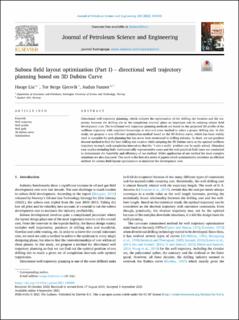| dc.contributor.author | Liu, Haoge | |
| dc.contributor.author | Gjersvik, Tor Berge | |
| dc.contributor.author | Faanes, Audun | |
| dc.date.accessioned | 2021-11-03T08:20:46Z | |
| dc.date.available | 2021-11-03T08:20:46Z | |
| dc.date.created | 2021-10-20T22:45:12Z | |
| dc.date.issued | 2022 | |
| dc.identifier.issn | 0920-4105 | |
| dc.identifier.uri | https://hdl.handle.net/11250/2827431 | |
| dc.description.abstract | Directional well trajectory planning, which includes the optimization of the drilling site location and the trajectory between the drilling site to the completion interval, plays an important role in reducing subsea field development cost. The traditional well trajectory planning methods are based on the projected 2D profile of the wellbore trajectory with empirical knowledge or trial-and-error method to select a proper drilling site. In this study, we propose a new efficient optimization method based on the 3D Dubins curve, which has been widely used in autopilot for path planning but has never been mentioned in drilling industry. In short, we use gradient descent method to find the best drilling site location while adopting the 3D Dubins curve as the optimal wellbore trajectory to reach each completion interval so that the “-site--wells” problem can be easily solved. Abundant case studies including both mathematically representative cases and the real practical field cases are conducted to demonstrate the feasibility and efficiency of our method. Wider application of our method for more complex situations are also discussed. This work is the first of a series of papers which systematically introduce an efficient method for subsea field layout optimization to minimize the development cost. | en_US |
| dc.language.iso | eng | en_US |
| dc.publisher | Elsevier | en_US |
| dc.rights | Navngivelse 4.0 Internasjonal | * |
| dc.rights.uri | http://creativecommons.org/licenses/by/4.0/deed.no | * |
| dc.title | Subsea field layout optimization (Part I) – directional well trajectory planning based on 3D Dubins Curve | en_US |
| dc.type | Peer reviewed | en_US |
| dc.type | Journal article | en_US |
| dc.description.version | publishedVersion | en_US |
| dc.source.volume | 208 | en_US |
| dc.source.journal | Journal of Petroleum Science and Engineering | en_US |
| dc.identifier.doi | https://doi.org/10.1016/j.petrol.2021.109450 | |
| dc.identifier.cristin | 1947452 | |
| dc.relation.project | Norges forskningsråd: 237893 | en_US |
| cristin.ispublished | true | |
| cristin.fulltext | original | |
| cristin.qualitycode | 2 | |

